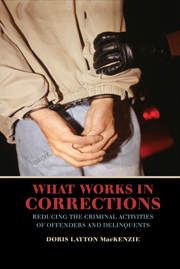Book contents
- Frontmatter
- Contents
- Acknowledgments
- PART ONE STRATEGIES FOR REDUCING CRIME
- PART TWO THE EFFECTIVENESS OF REHABILITATION PROGRAMS
- 5 Academic Education and Life Skills Programs
- 6 Vocational Education and Work Programs
- 7 Cognitive Behavioral Therapy Programs
- PART THREE TARGETING SPECIFIC TYPES OF OFFENDERS
- PART FOUR MANAGEMENT AND TREATMENT OF SUBSTANCE ABUSERS
- PART FIVE CONTROL, DISCIPLINE, AND PUNISHMENT
- PART SIX CONCLUSIONS
- References
- Index
- CAMBRIDGE STUDIES IN CRIMINOLOGY
6 - Vocational Education and Work Programs
Published online by Cambridge University Press: 27 July 2009
- Frontmatter
- Contents
- Acknowledgments
- PART ONE STRATEGIES FOR REDUCING CRIME
- PART TWO THE EFFECTIVENESS OF REHABILITATION PROGRAMS
- 5 Academic Education and Life Skills Programs
- 6 Vocational Education and Work Programs
- 7 Cognitive Behavioral Therapy Programs
- PART THREE TARGETING SPECIFIC TYPES OF OFFENDERS
- PART FOUR MANAGEMENT AND TREATMENT OF SUBSTANCE ABUSERS
- PART FIVE CONTROL, DISCIPLINE, AND PUNISHMENT
- PART SIX CONCLUSIONS
- References
- Index
- CAMBRIDGE STUDIES IN CRIMINOLOGY
Summary
INTRODUCTION
Work has been an important part of the daily activities of inmates from almost the inception of penitentiaries. Originally, the Pennsylvania penitentiary system called for solitary confinement without work. The rationale for this was to give offenders time to reflect on their crimes and repent; however, the terrible psychological and physical effects of such isolation soon became apparent. To maintain their health, inmates were provided with moral and religious instruction and work. They were expected to work from eight to ten hours per day in isolation in their cells. The “Great Law” of William Penn and the Quakers advocated hard labor in place of capital punishment for those convicted of serious crimes.
Work was also the major component of the Auburn or “congregate” system. In contrast to the isolated work in the Pennsylvania system, inmates in Auburn prisons worked in group settings. The daily routine included congregate work in shops during the day, separation of prisoners into small cells at night, silence at all times, and lockstep marching formations. Silence was enforced because verbal exchanges between prisoners were believed to be contaminating. Advocates for the Auburn system argued that these prisons were cheaper to construct, offered better vocational training for the inmates, and produced more money for the state. The economic advantage is most likely one of the major reasons the congregate system was adopted in almost all American prisons. The development of prosperous prison industries was also a major concern of wardens (McKelvey, 1972).
- Type
- Chapter
- Information
- What Works in CorrectionsReducing the Criminal Activities of Offenders and Deliquents, pp. 90 - 111Publisher: Cambridge University PressPrint publication year: 2006



